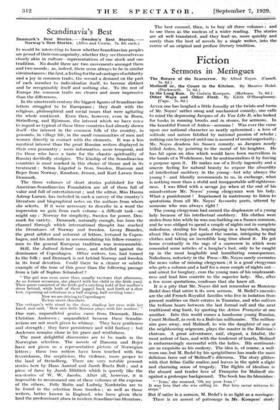Scandinavia's Best
Denmark's Best Stories.—Sweden's Best Stories. Norway's Best Stories. (Allen and Unwin. 7s. 6d. each.) IT would be interesting to know whether Scandinavian peoples are proud of their consanguinity, whether they see themselves as closely akin in culture—representatives of one stock and one
tradition. No doubt there are two movements amongst them and two moods; as, indeed, there seem always to be in similar circumstances : the first, a feeling forthe advantages of solidarity
and a joy in common traits, the second a demand on the part of each member to individualize itself, to become distinct and be recognizably itself and nothing else. To the rest of Europe the common traits are clearer and more impressive than the differences.
In the nineteenth century the biggest figures of Scandinavian letters struggled to be Europeans ; they dealt with the religious, philosophical and social issues that were agitating the whole continent. Even then, however, even in Ibsen, Strindberg, and Bjornson, the interest which we have core to regard as typical of these three countries had already shown itself—the interest in the common folk of the country, in peasants, in village life, in the small communities of men and women directly in contact with the elements. It was a less mystical interest than the great Russian writers displayed in their own peasantry ; more informative, more temporal, and (to those who have a taste for the chaotic spirituality of Russia) decidedly stodgier. The kinship of the Scandinavian countries is most marked in this choice of theme and in its treatment : Selma Lagerlof is from Sweden, Hamsun and Bojer from Norway, Knudsen, Jensen, and Karl Larsen from Denmark.
The three volumes of short stories published for the American-Scandinavian Foundation are all of them full of value and full of entertainment ; and the editor, Miss Hanna Astrup Larsen, has included in each a survey of the country's literature and biographical notes on the authors from whom she selects. If it were necessary to describe in a word the impression we gain from each volume —a difficult task—we might say : Norway for simplicity, Sweden for power, Den- mark for variety. Denmark, naturally enough, has been the channel through which international thought has reached the literatures of Norway and Sweden. Georg Brandes, the great arbiter and autocrat of letters, lectured in Copen- hagen, and his influence in accommodating his fellow-country- men to the general European tradition was immeasurable.
Still, the Jutland School came, and rebelled against the dominance of Copenhagen. Other writers, too, had turned
to the folk : and Denmark is not behind Norway and Sweden
in its local devotion. Could there be a clearer or subtler example of the tone of this genre than the following passage from a tale of Sophus Sehandorf ?
" The girl was even more than usually taciturn that afternoon. As on former occasions, she played with her child in the little yard. Their game consisted of the little girl's catching hold of her mothees dress behind, while both of them -jogged back and forth at a slow trot, ropeating ad infinitum in a half-singing, half-reciting tone :
Now we are driving to Copenhagen To buy sweet chocolate.
The cottager's wife stood in the door, shading her eyes with her hand, and said, ' How nice little Marsina plays with her mother.' "
One rare, unparalleled genius came from Denmark, Hans Christian Andersen ; unparalleled because these Scandin- avians are not much given to whimsy. They have gentleness and strength ; they have persistence and wild fantasy ; but Andersen remains alone in his grace and wistfulness.
The most delightful discoveries are to be made in the Norwegian selection. The novels of Hamsun and Bojer have not given us a representative picture of Norwegian letters ; these two writers have been touched with the feverishness, the scepticism, the violence, more proper to the land of Strindberg. There are very notable peasant stories here by Hans Aanrud and Jacob Breda Bull ; and a piece of farce by Jacob Hilditch which is queerly like the sea-stories of W. W. Jacobs. After all, however, it is impossible to recommend one of these volumes at the expense of the others. Pellc Molin and Ludwig Nordstrom are .to be found in the selection from Sweden ; as well as those writers, better known in England, who have given their land the predominant place in modern Scandinavian literature. The best counsel, then, is to buy all three volumes ; and to use them- as the nucleus of a wider reading. The stories are all well translated, and-they lead- us, more quickly and surely than the best of novels by a single writer,, into the centre of an original and profuse literary tradition. -
































 Previous page
Previous page